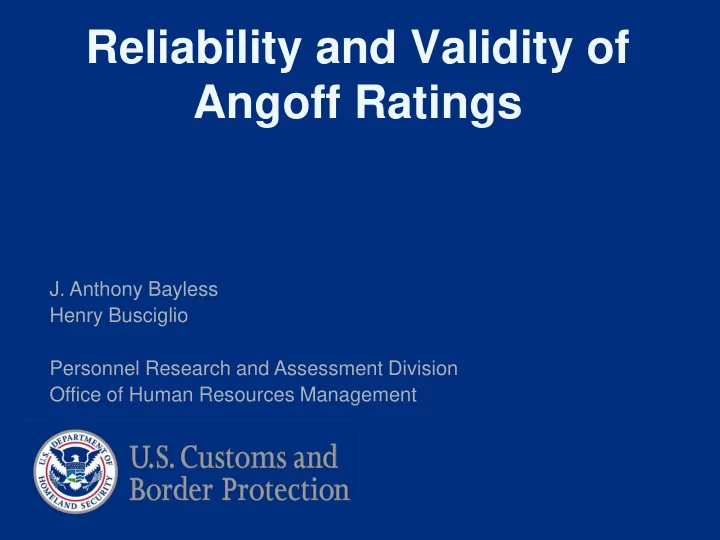

Reliability and Validity of Angoff Ratings J. Anthony Bayless Henry Busciglio Personnel Research and Assessment Division Office of Human Resources Management
Standard Setting Process to establish a performance standard, cut score, or passing score Process not purely technical or empirical Process involves value judgments ( Standards for Educational and Psychological Testing ) Various methods of standard setting, for example: Contrasting Groups and Borderline Groups (Livingston & Zieky, 1982) Angoff (1971) Ebel (1972) Nedelsky (1954) OHRM/PRAD June 10, 2008 2
Angoff Procedure SMEs are administered the test SMEs estimate the proportion of “minimally qualified” or “minimally competent” examinees who would answer each item correctly Average Angoff rating is calculated for each item Grand average of the Angoff ratings across items is calculated to represent the recommended performance standard (or cut score) OHRM/PRAD June 10, 2008 3
Promotional Assessments Career Experience Inventory Critical Thinking Skills In-Basket Job Simulation Managerial Writing Skills Job Knowledge Test OHRM/PRAD June 10, 2008 4
Job Knowledge Test 80 items for each occupation’s (IEA and DO) test Multiple-choice items with four response options Dichotomously scored items Power tests OHRM/PRAD June 10, 2008 5
Research Interest How good are SMEs at conceptualizing and consistently applying a hypothetical construct of “minimally qualified” examinees? Specifically, how reliable are the SME estimates? Specifically, how valid are the SME estimates? OHRM/PRAD June 10, 2008 6
Methodology – Angoff IEA SMEs DO SMEs n=5 (Time 1 + Time 2) n=8 No group discussion Group discussion OHRM/PRAD June 10, 2008 7
Methodology - Study Two post hoc studies, one per occupation DO sample (N=259 examinees) IEA sample (N=318 examinees) Assessed interjudge reliability via internal consistency estimate of reliability Assessed validity via correlation of average Angoff rating and actual (observed) item difficulty index for a “minimally qualified” group of examinees OHRM/PRAD June 10, 2008 8
Results - Reliability DO Sample (72 scored items, 8 SMEs) Alpha = .863, no removable SMEs Item-total correlations from .582 to .680 IEA Sample (70 usable items, 5 SMEs) Initial Alpha = .429, with 2 removable SMEs Final Alpha = .547, using 3 SMEs Item-total correlations from .364 to .422 We used both 5- and 3-SME groups for further analyses. OHRM/PRAD June 10, 2008 9
Results - Validity Validity - agreement between SMEs’ Angoff estimates and actual p- values among group of “minimally qualified” test takers. “Minimally qualified” defined two ways: Candidates scoring close to 50 th percentile Candidates getting 70% of items correct Used both correlations and t-tests to assess validity OHRM/PRAD June 10, 2008 10
Results – Validity (Corr.) For DO sample, correlations were: .591** for 50 th percentile group .479** for 70% correct group For IEA sample, correlations (for 5- and 3-SME groups, respectively) were: .311** and .243* for 50 th percentile group .282* and .183 for 70% correct group ** p<.01. *p<.05. OHRM/PRAD June 10, 2008 11
Results – Validity (T-tests) Agreement – magnitude of mean differences between the Angoff ratings for each item and the corresponding p-value among minimally qualified test takers. Used paired-samples t-tests For DO sample: Grand average Angoff rating = .6310 Average p-value for 50 th percentile group = .6315 t = 0.025, df = 71, p = .980 Average p-value for 70% correct group = .6906 t = 2.750, df = 71, p = .008 OHRM/PRAD June 10, 2008 12
Results – Validity (T-tests) For IEA sample: Grand average Angoff ratings 5-SME = .7716 3-SME = .7710 Average p-values 50 th percentile group = .6810 70% correct group = .6980 OHRM/PRAD June 10, 2008 13
Results – Validity (T-tests) For IEA sample, continued: Comparisons: 1: 50 th perc p-values compared to 5-SME Angoffs t = -3.233, p = .002 2: 70% corr p-values compared to 5-SME Angoffs t = -2.685, p = .009 3: 50 th perc p-values compared to 3-SME Angoffs t = -3.148, p = .002 4: 70% corr p-values compared to 3-SME Angoffs t = -2.587, p = .012 OHRM/PRAD June 10, 2008 14
Results – Validity (T-tests) IEA T-Test Comparisons 50th Percentile p -values 70% Correct p -values Avg. Angoffs for t = -3.233 t = -2.685 5 SMEs p = .002 p = .009 Avg. Angoffs for t = -3.148 t = -2.587 3 SMEs p = .002 p = .012 OHRM/PRAD June 10, 2008 15
Results – Summary DO SMEs gave reasonably reliable and valid estimates of actual p-values, especially for test takers at the 50 th percentile. IEA SMEs gave less reliable and valid estimates by exhibiting less interrater agreement, demonstrating less insight into the relative difficulty of items, and overestimating p-values. The notably superior performance of the DO SMEs is reasonable given the differences between the procedures used to obtain Angoff estimates from the two groups. OHRM/PRAD June 10, 2008 16
Limitations of Current Study Post hoc studies Did not retain initial round of Angoff ratings prior to group discussions during second round OHRM/PRAD June 10, 2008 17
How Does This Help You? The more SMEs, the merrier! Group discussion is critical SMEs need to be experienced and representative of occupational workforce OHRM/PRAD June 10, 2008 18
References American Educational Research Association, American Psychological Association, National Council on Measurement in Education. (1999). Standards for educational and psychological testing. Washington, DC: American Psychological Association. Angoff, W.H. (1971). Scales, norms, and equivalent scores. In R.L. Thorndike (Ed.), Educational measurement (pp. 508-600). Washington, DC: American Council on Education. Cizek, G.J. (2001). Setting performance standards: Concepts, methods, and perspectives. Mahwah, NJ: Lawrence Erlbaum Associates. Cizek, G. J., Bunch, M. B., & Koons, H. (2004). Setting performance standards: Contemporary methods. Educational measurement: Issues and practice, 23(4), 31-50. OHRM/PRAD June 10, 2008 19
References (continued) Ebel, R.L. (1972). Essentials of educational measurement . Englewood Cliffs, NJ: Prentice-Hall. Goodwin, L.D. (1999). Relations between observed item difficulty levels and Angoff minimum passing levels for a group of borderline examinees. Applied measurement in education, 12(1), 13-28. Nedelsky, L. (1954). Absolute grading standards for objective tests. Educational and psychological measurement, 14, 3-19. OHRM/PRAD June 10, 2008 20
Recommend
More recommend